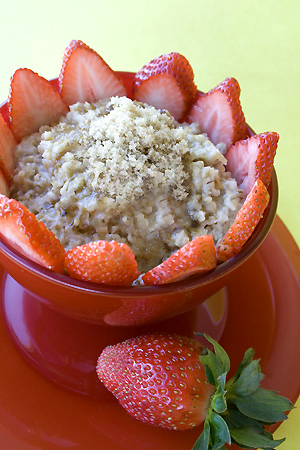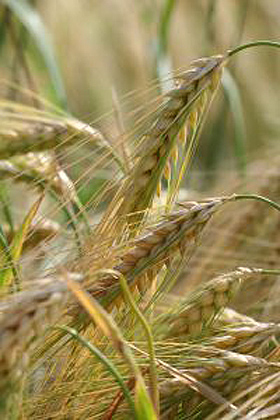 |

| |

Ready for breakfast: crunchy, textured oatmeal topped with brown sugar. Photography by Claire Freierman. |
| WHAT IT IS: “Gourmet” oatmeal. |
| WHY IT’S DIFFERENT: A blend of oatmeal and six other whole grains creates great texture and flavor—a world apart from Quaker Oats and other brands. |
| WHY WE LOVE IT: The texture and the taste— Cranberry Almond Oatmeal, for example, is not redolent of cherries and almonds. There’s just a nice, subtle touch. |
| WHERE TO BUY IT: HollysOatmeal.com |
|
|
 |

Holly’s Oatmeal:
Perfect Porridge
Page 2: Different Types Of Oats
This is Page 2 of a four-page review. Click on the black links below to visit other pages.
INDEX OF REVIEW
MORE TO DISCOVER
|
| |
|
|
Types Of Oats
After harvest, the hull is removed from the oats and the groats (kernels) are toasted to stabilize enzymes that cause rancidity. Then, they are variously coarsely ground into meal (crushed oats), steamed and rolled on steel or stone rollers to make rolled oats or cut into small pieces to make steel-cut oats. While the whole oat groats can be purchased, and are more nutritious because they are minimally processed, they require a long time to cook and are very chewy—not the soft food that we know as oatmeal.
The longer you cook oats, the more texture and flavor they have. The longest-cooking are steel-cut oats, then rolled oats, then quick oats, then instant oats.
Crushed Oats
Crushed oats are groats that are lightly ground in a hammer mill, creating a meal-type product. It’s unusual to find them in U.S. markets. Boiling crushed oats creates a porridge with a farina texture. Uncooked, crushed oats are also a favorite food of the equine and bovine populations (only 5% of the oats grown in the world are consumed by humans). Crushed oats are also used in oatmeal-based health and beauty aids.
|

At harvest, the grains are removed from the husks and toasted, creating the whole oat kernels known as groats. The toasted oats retain much of the nutritional value of the raw grain. Photo by Christophe Libert | IST. |
Rolled Oats
Rolled oats are what most Americans think of as oatmeal. It is a whole grain food, an excellent source of niacin, riboflavin and iron, and helps to bolster energy levels. Quaker Oats’ standard product is called Old Fashioned Oats, a term used by other companies as well for their standard rolled oat product. Standard rolled oats are also known as flaked oats and oat flakes: the groats are steamed and then rolled and flaked. The calibration of the rollers produces a spectrum of products, including instant oats, quick oats, rolled oats/old-fashioned oats and thick-rolled oats. The thinner the oats are rolled, the more surface area, the quicker they cook. The thinner the flake, the quicker the oats cook because of the greater surface area of the grain. Rolled oats cook in five minutes.
Instant Oats
If you don’t have time or facility to cook, instant oatmeal is made from oats that are rolled very thin and precooked, then dehydrated. They are generally packaged in single-serve packets and need only be mixed with a hot liquid to plump up into oatmeal. While you can’t beat the convenience, they lack the texture and flavor of cooked oats (although the nutrition is about the same, and some brands like Quaker enrich their product with extra vitamins and/or calcium). We like keeping boxes of these in our desk drawer at work, for a healthier breakfast than a bagel or other workplace option, and a nutritious snack anytime of the day or night. They cook “instantly” when boiling water or milk is added; or can be cooked in the microwave with cold water for 90 seconds.
Quick Oats
Quick oats are rolled oats that are thicker and thus chewier than instant oats, but not as thick as regular rolled oats. They cook in one minute.
Steel-Cut Oats
Oatmeal imported from Ireland and Scotland tends to be steel-cut oats. Steel cut oats are also called cut oats, Irish or Scottish Oats and coarse-cut oats. The groats have been cut into very small pieces, not rolled into flakes. Cooking time is considerably longer than for rolled oats—30 minutes—but the cooked oatmeal has a nice texture to it—it’s more al dente than rolled oats.
Continue To Page 3: Oatmeal Varieties & Toppings
Go To The Article Index Above
FOR ADDITIONAL INFORMATION, special offers,
contests, opinion surveys, THE NIBBLE
back issues archive, product gift-finder, links to our favorite
food websites, and the ability to nominate your favorite nibbles,
visit the home page of TheNibble.com.
Do you have friends who would enjoy THE NIBBLE?
Click here to send them an invitation to sign up for their own copy. |
© Copyright 2004-2025 Lifestyle Direct, Inc. All rights
reserved. All information contained herein is subject to change at any time
without notice. All details must be directly confirmed with manufacturers, service
establishments and other third parties. The material in this e-zine may not
be reproduced, distributed, transmitted, cached, or otherwise used, except with
the prior written permission of Lifestyle Direct, Inc.
|
 |




|
 |











